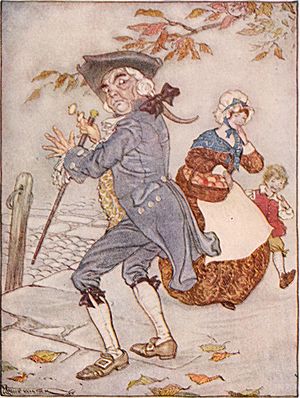Frances Jenkins Olcott facts for kids
Frances Jenkins Olcott (born in 1872, died in 1963) was a very important person in the world of libraries and children's books. She was the first person to lead the children's department at the Carnegie Library of Pittsburgh in 1898. She also wrote many books for kids and for people who work as librarians for children and young adults.
Contents
Early Life and Learning
Frances Olcott was born in 1872 in Paris, France, near a beautiful garden called the Batignolles. Later, she lived in Albany, New York, first with her parents and grandmother, and then in the countryside outside Albany. Her parents taught her at home, giving her a strong start in her education.
Her father, Franklin Olcott, was born in America but studied in Germany. He worked for the American government in other countries. He taught Frances German and classic subjects. Her mother, Julia Olcott, translated children's stories from French. Frances said that her parents' love for words, poetry, and research greatly helped her develop her thinking and writing skills. She also mentioned that her religious upbringing, with her grandmother's formal influence and her parents' daily Bible readings and prayers, was important for her writing.
She finished high school by passing special tests called Regents Examinations. After that, she took entrance exams for the New York State Library School and graduated in 1896.
Career Highlights
Becoming a Librarian
Frances Olcott started her library career as an assistant librarian at the Brooklyn Public Library from 1897 to 1898. Then, she moved to the Carnegie Library of Pittsburgh. Here, she became the very first librarian to create and lead a special department just for children! She also started a formal training program called The Training School for Children's Librarians.
Her children's department was like a special lab. She and her team tried out new ways to get kids excited about reading. They figured out what kinds of books children liked best and how to organize them. They shared what they learned with other libraries and schools. Her smart and dedicated staff, including two expert book researchers, helped create the training school she led.
Frances Olcott also started programs to bring books to homes, schools, and even places like detention centers. Her work helped many immigrant families at the time learn about their new country. She encouraged families to have their own small libraries at home. She and her colleagues would even hold "reading hours" where groups of children would meet in a home in the community to listen to librarians read stories.
Becoming a Writer
In 1911, Frances Olcott left Pittsburgh and her librarian job. She moved back to New York to focus on writing. She wrote books for children and also books that taught others how to be great children's librarians. She wrote and edited more than 24 books, which earned over half a million dollars during her lifetime!
The American Library Association even asked her to write a section called "Library Works with Children" for their 1914 Manual of Library Economy, which is like a guide for librarians.
Published Works
- 1898 "Fairy Tales for Children", a list of books
- 1905 "Rational Library Work and the Preparation for It"
- 1909 "Story Telling: A Public Library Method"
- 1910 "The Public Library: A Social Force in Pittsburgh"
- 1912 The Children's Reading
- 1913 The Arabian Nights' Entertainments, translated by Edward William Lane; chosen, edited, and arranged by Olcott; illustrated by Monro S. Orr
- 1913 Story-telling Poems
- 1914 Good Stories for Great Holidays
- 1914 "Library Work with Children", for the American Library Association
- 1915 More Tales from the Arabian Nights, translated by Lane, edited by Olcott, illustrated by Willy Pogány
- 1915 The Jolly Book for Boys and Girls, edited by Olcott and Amena Pendleton, illustrated by Amy M. Sacker
- 1917 Tales of the Persian Genii, illustrated by Willy Pogány
- 1917 The Red Indian Fairy Book, illustrated by Frederick Richardson
- 1918 The Book of Elves and Fairies, illustrated by Milo Winter
- 1919 The Wonder Garden: Nature Myths and Tales from All the World Over, illustrated by Milo Winter
- 1920 Story-telling Ballads, Selected and Arranged, illustrated by Milo Winter
- 1922 Grimm's Fairy Tales, illustrated by Rie Cramer
- 1922 Good Stories for Great Birthdays
- 1922 Stories about George Washington: with a selection of famous poems
- 1925 Wonder Tales from China Seas, illustrated by Dugald Stewart Walker
- 1926 Wonder Tales from Windmill Lands, illustrated by Herman Rosse
- 1927 Wonder Tales from Pirate Isles, illustrated by Herman Rosse
- 1928 Wonder Tales from Baltic Wizards, illustrated by Victor G. Candell
- 1929 Wonder Tales from Fairy Isles, illustrated by Constance Whittemore
- 1930 Wonder Tales from Goblin Hills, illustrated by Harold Sichel,
- The books from 1918, 1919, and 1920 that were illustrated by Milo Winter were collections published by Houghton Mifflin. Their title pages had longer names, each continuing with "for Story-telling and Reading Aloud and for the Children's Own Reading".


